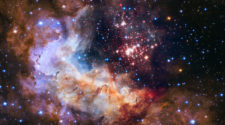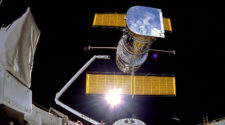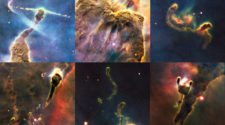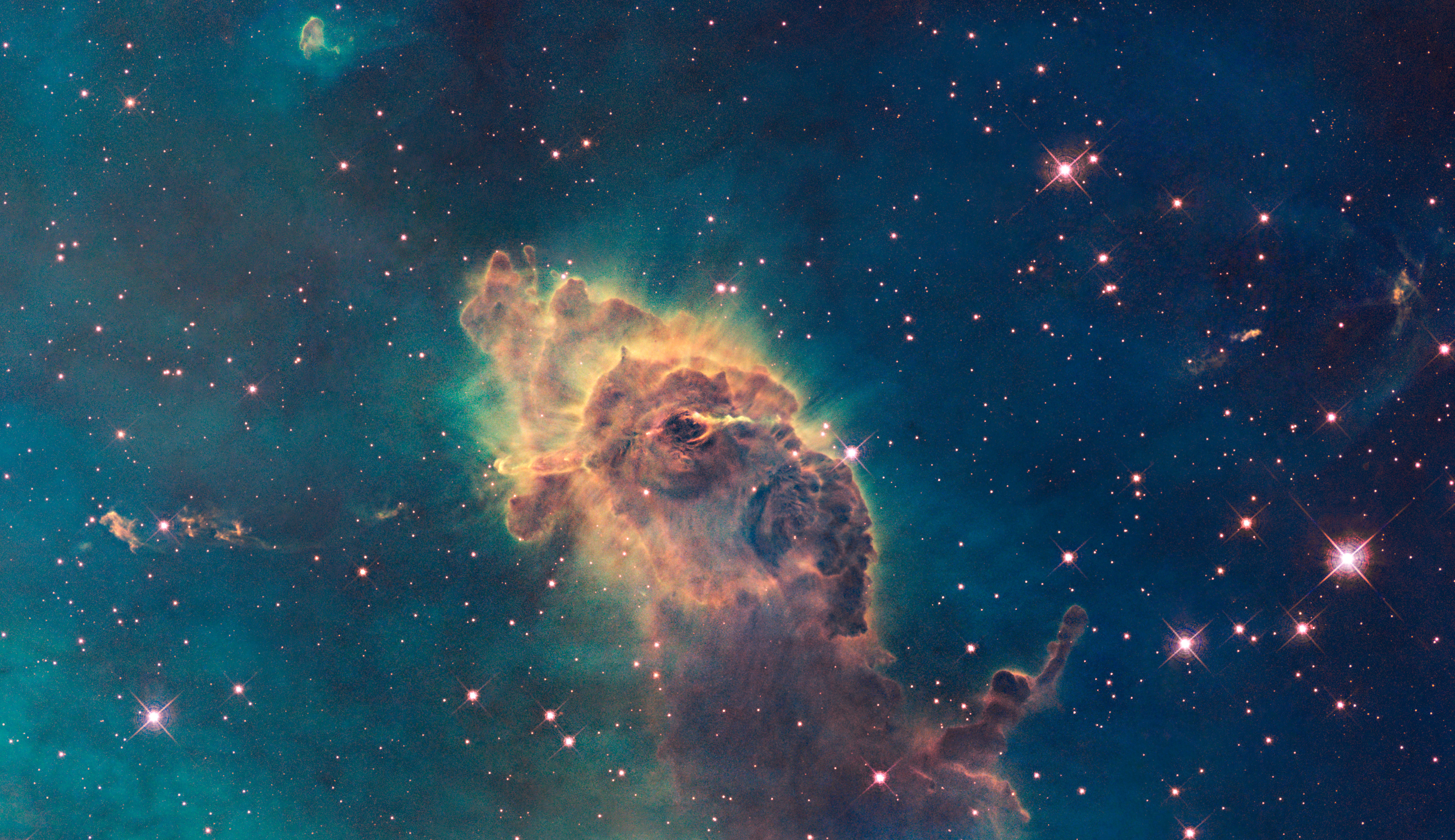
61. Carina Nebula
Composed of gas and dust, the pictured pillar resides in a tempestuous stellar nursery called the Carina Nebula, located 7500 light-years away in the southern constellation of Carina.
Taken in visible light, the image shows the tip of the three-light-year-long pillar, bathed in the glow of light from hot, massive stars off the top of the image. Scorching radiation and fast winds (streams of charged particles) from these stars are sculpting the pillar and causing new stars to form within it. Streamers of gas and dust can be seen flowing off the top of the structure.
Hubble’s Wide Field Camera 3 observed the Carina Nebula on 24-30 July 2009. WFC3 was installed aboard Hubble in May 2009 during Servicing Mission 4. The composite image was made from filters that isolate emission from iron, magnesium, oxygen, hydrogen and sulphur.
These Hubble observations of the Carina Nebula are part of the Hubble Servicing Mission 4 Early Release Observations.
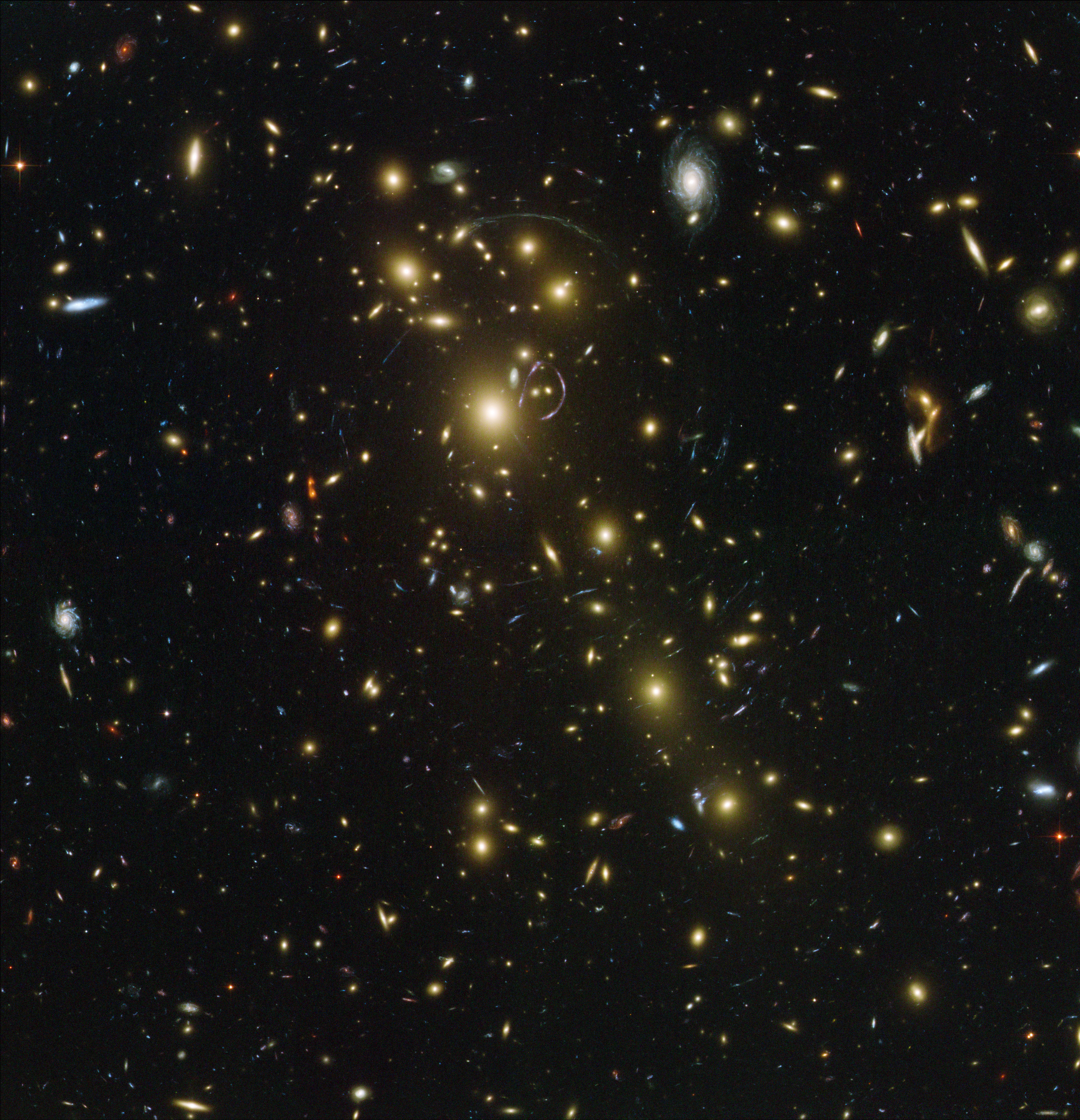
62. Abell 1703
Located in the northern celestial hemisphere, Abell 1703 is composed of over one hundred different galaxies that act as a powerful cosmic telescope, or gravitational lens. The gravitational lens produced by the massive galaxy cluster in the foreground (the yellow mostly elliptical galaxies scattered across the image) bends the light rays in a way that can stretch the images and so amplify the brightness of the light rays from more distant galaxies. In the process it distorts their shapes and produces multiple banana-shaped images of the original galaxies. The result is the stunning image seen here – a view deeper into the Universe than possible with current technology alone. Abell 1703 is located at 3 billion light-years from the Earth (redshift 0.26).
“The Hubble Space Telescope is the greatest astronomical instrument yet created by humankind. Since its launch 25 years ago, it has provided discoveries well beyond what we expected to learn.
“Some of the most dramatic discoveries have been of distant galaxies in the early universe. Due to the bright emission in the near-infrared from our Earth’s atmosphere, only Hubble can obtain the deep imaging necessary to discover galaxies hailing from less than one billion years after the Big Bang. These observations over the past few years have proved astounding – the early universe is teeming with galaxies!
“This is one of Hubble’s lasting legacies – a small telescope, with a mirror the size of your typical NBA center – can teach us about how galaxies are growing only 500 million years after the Big Bang. This is one dramatic bang for your buck!”
Dr. Steven Finkelstein
Assistant Professor of Astronomy
University of Texas at Austin
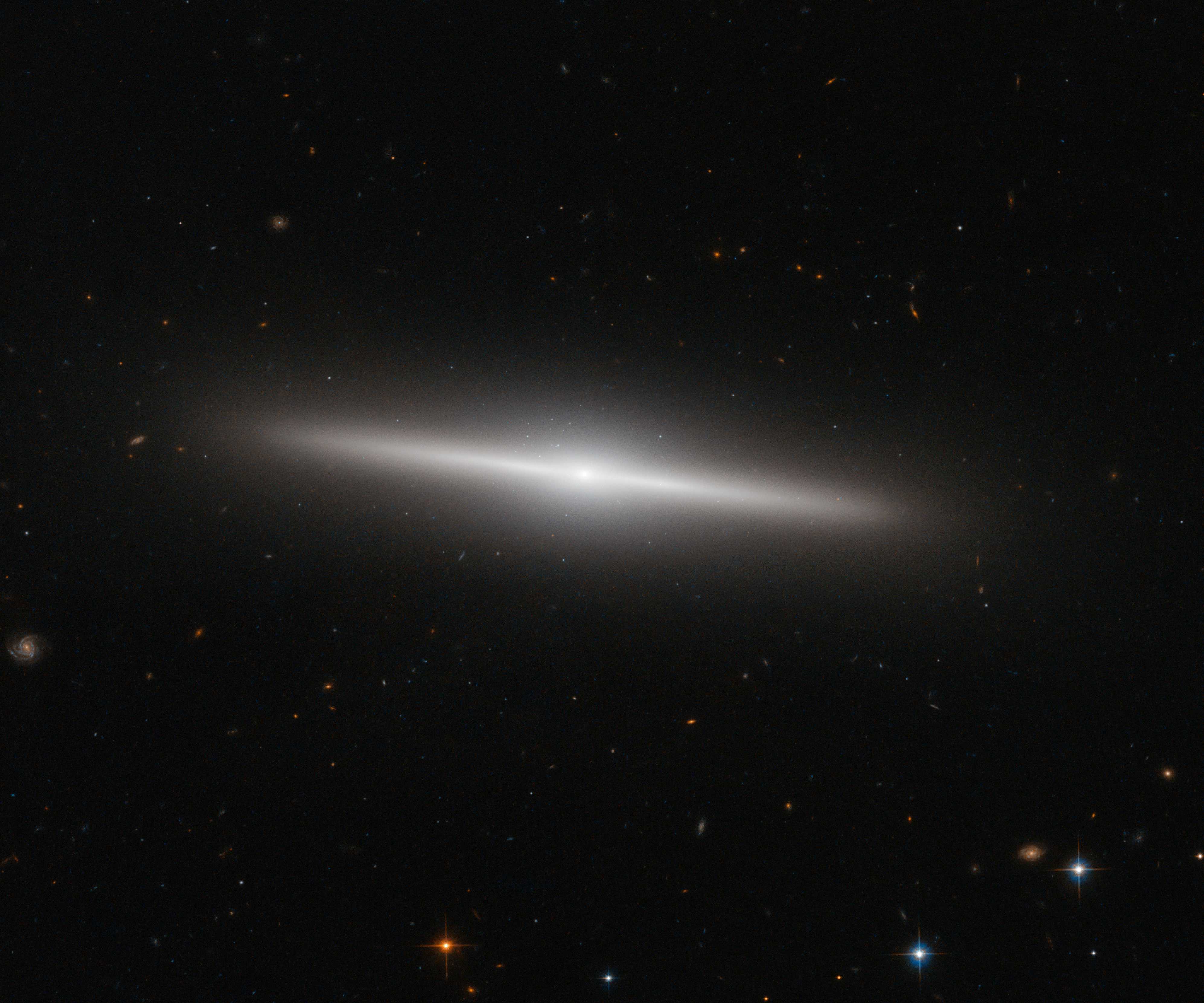
63. The beautiful side of IC 335
This Hubble Space Telescope image shows the galaxy IC 335 in front of a backdrop of distant galaxies. IC 335 is part of a galaxy group containing three other galaxies, and located in the Fornax Galaxy Cluster 60 million light-years away.
As seen in this image, the disc of IC 335 appears edge-on from the vantage point of Earth. This makes it harder for astronomers to classify it, as most of the characteristics of a galaxy’s morphology — the arms of a spiral or the bar across the centre — are only visible on its face. Still, the 45 000 light-year-long galaxy could be classified as an S0 type.
These lenticular galaxies are an intermediate state in galaxy morphological classification schemes between true spiral and elliptical galaxies. They have a thin stellar disc and a bulge, like spiral galaxies, but in contrast to typical spiral galaxies they have used up most of the interstellar medium. Only a few new stars can be created out of the material that is left and the star formation rate is very low. Hence, the population of stars in S0 galaxies consists mainly of aging stars, very similar to the star population in elliptical galaxies.
As S0 galaxies have only ill-defined spiral arms they are easily mistaken for elliptical galaxies if they are seen inclined face-on or edge-on as IC 335 here. And indeed, despite the morphological differences between S0 and elliptical class galaxies, they share a some common characteristics, like typical sizes and spectral features.
Both classes are also early-type galaxies, as they are evolving passively. However, elliptical galaxies may be passively evolving when we observe them, but they had violent interactions with other galaxies in their past. Whereas S0 galaxies are either aging and fading spiral galaxies, which never had any interactions with other galaxies, or they are the aging result of a single merger between two spiral galaxies in the past. The exact nature of these galaxies is still a matter of debate.
“I think the most important discoveries made by Hubble have always been the unanticipated ones. For example, Hubble played a role in the discovery of dark energy and the accelerating universe. Hubble has also allowed astronomers to study the evolution of galaxies over most of cosmic history, revealing that galaxies in the early universe look remarkably different from local galaxies.”
Dr. Katherine E. Whitaker
NASA Postdoctoral Program Fellow
Goddard Space Flight Center
Greenbelt, Maryland

64. Whirling disc of NGC 4526
This neat little galaxy is known as NGC 4526. Its dark lanes of dust and bright diffuse glow make the galaxy appear to hang like a halo in the emptiness of space in this image from Hubble.
Although this image paints a picture of serenity, the galaxy is anything but. It is one of the brightest lenticular galaxies known, a category that lies somewhere between spirals and ellipticals. It has hosted two known supernova explosions, one in 1969 and another in 1994, and is known to have a colossal supermassive black hole at its centre that has the mass of 450 million Suns.
NGC 4526 is part of the Virgo cluster of galaxies. Ground-based observations of galaxies in this cluster have revealed that a quarter of these galaxies seem to have rapidly rotating discs of gas at their centres. The most spectacular of these is this galaxy, NGC 4526, whose spinning disc of gas, dust, and stars reaches out uniquely far from its heart, spanning some 7% of the galaxy’s entire radius.
This disc is moving incredibly fast, spinning at more than 250 kilometres per second. The dynamics of this quickly whirling region were actually used to infer the mass of NGC 4526’s central black hole — a technique that had not been used before to constrain a galaxy’s central black hole.
This image was taken using Hubble’s Wide Field Planetary Camera 2.
“It’s the sharpness, depth, and details in the images. So much better than anything ever taken from the ground.”
Dr. Bradley M. Peterson and Dr. Gisella De Rosa
(Peterson) Professor and Chair of Astronomy, Ohio State University, Columbus, Ohio
(De Rosa) Visiting Astronomer, Space Telescope Science Institute, Baltimore, Maryland
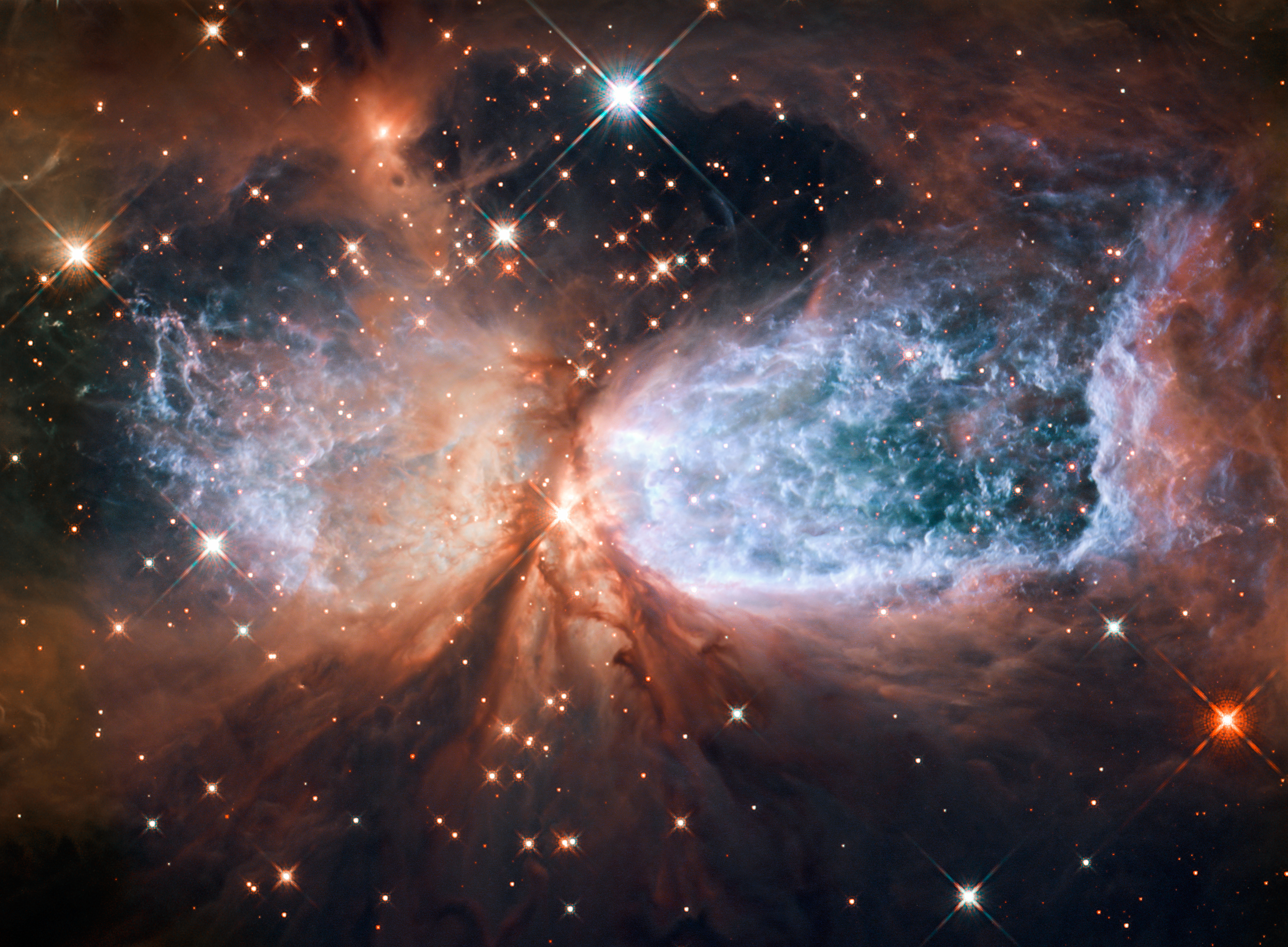
65. Star-forming region S106
This image shows Sh 2-106, or S106 for short. This is a compact star forming region in the constellation Cygnus (The Swan). A newly-formed star called S106 IR is shrouded in dust at the centre of the image, and is responsible for the surrounding gas cloud’s hourglass-like shape and the turbulence visible within. Light from glowing hydrogen is coloured blue in this image.
“Hubble is much more than a telescope, or a satellite: it is an outstanding masterpiece of human achievement. Not only do its spectacular pictures shape the way we think about the Universe, but at the same time the enormous efforts of the engineers and astronauts which kept it in orbit, and made it ever more powerful, are an unrivalled source of inspiration.”
Boris Gänsicke
Professor in the Department of Physics
University of Warwick
Coventry, United Kingdom
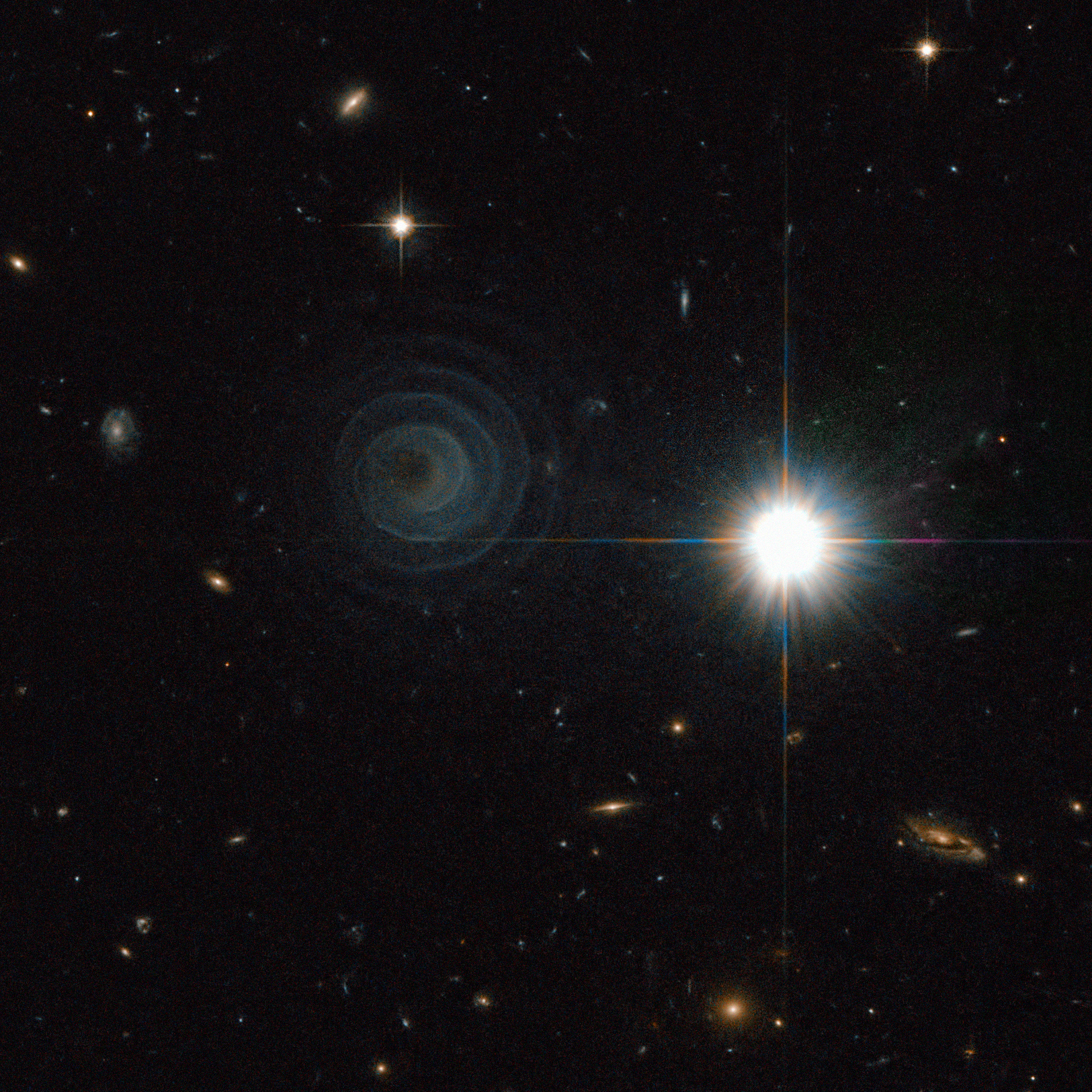
66. Extraordinary celestial spiral
This remarkable picture shows one of the most perfect geometrical forms created in space. It captures the formation of an unusual pre-planetary nebula, known as IRAS 23166+1655, around the star LL Pegasi (also known as AFGL 3068) in the constellation of Pegasus (the Winged Horse).
The striking picture shows what appears to be a thin spiral pattern of astonishingly regularity winding around the star, which is itself hidden behind thick dust. The material forming the spiral is moving outwards a speed of about 50 000 km/hour . Astronomers calculate that the shells are each separated by about 800 years.
The spiral is thought to arise because LL Pegasi is a binary system, with the star that is losing material and a companion star orbiting each other. The spacing between layers in the spiral is expected to directly reflect the orbital period of the binary, which is indeed estimated to be also about 800 years.
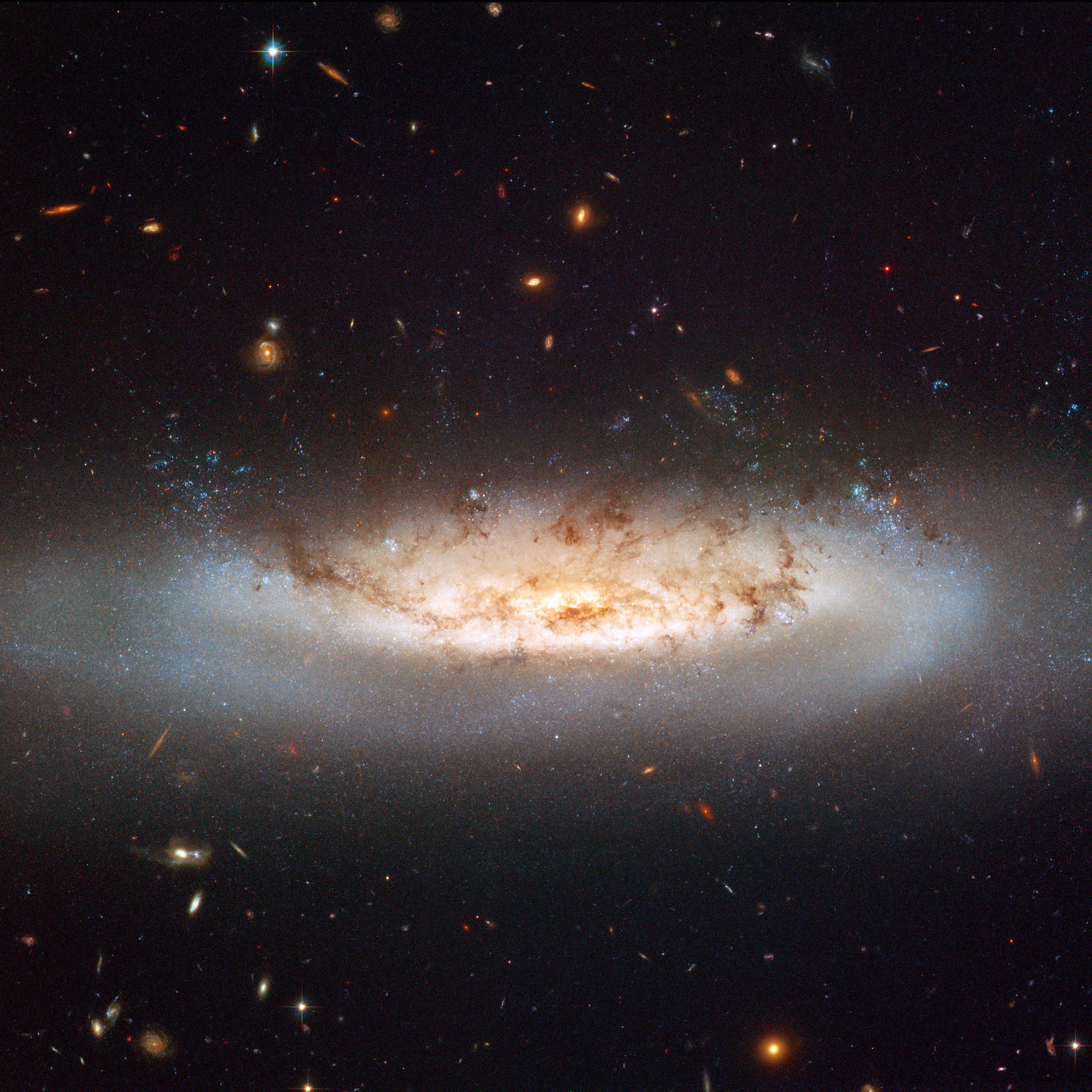
67. Stripping away at NGC 4522
Hubble allows astronomers to study an interesting and important phenomenon called ram pressure stripping that is so powerful, it is capable of mangling galaxies and even halting their star formation.
NGC 4522 is a spectacular example of a spiral galaxy that is currently being stripped of its gas content. Hubble’s view practically swirls off the page with apparent movement. It highlights the dramatic state of the galaxy with an especially vivid view of the ghostly gas being forced out of it. Bright blue pockets of new star formation can be seen to the right and left of centre.
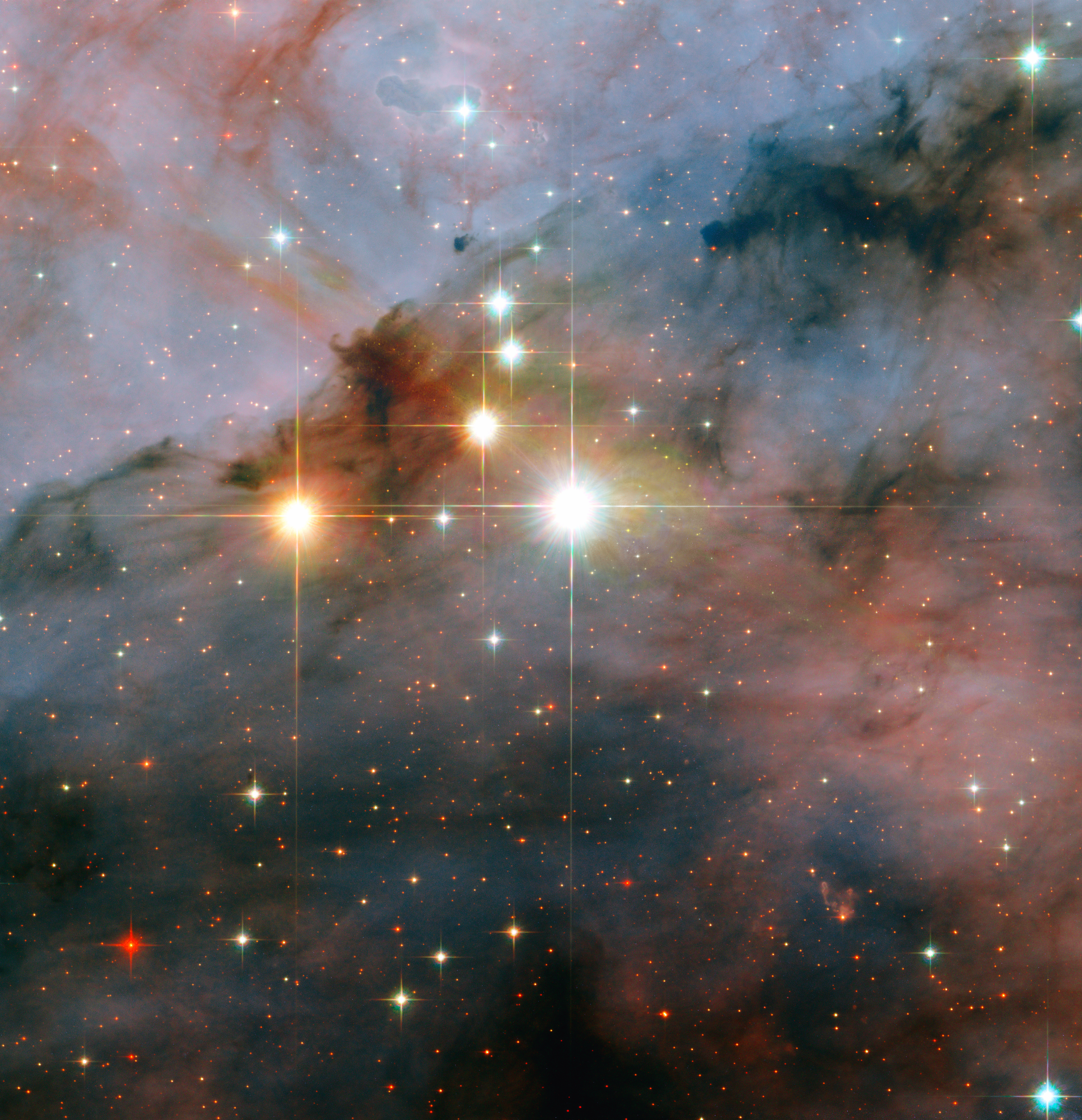
68. Pair of mammoth stars
The image shows a pair of colossal stars, WR 25 and Tr16-244, located within the open cluster Trumpler 16. This cluster is embedded within the Carina Nebula, an immense cauldron of gas and dust that lies approximately 7500 light-years from Earth in the constellation of Carina, the Keel. WR 25 is the brightest, situated near the centre of the image. The neighbouring Tr16-244 is the third brightest, just to the upper left of WR 25. The second brightest, to the left of WR 25, is a low mass star located much closer to the Earth than the Carina Nebula.
“The most fascinating things we are learning from Hubble in my area of expertise is the study of the most massive stars. These stars are very rare and have very short lives, astronomically speaking, ‘just a few million years’. This is because they are extremely bright, up to a million times brighter than our own star the Sun, which means that they quickly consume all their fuel.
“Their fuel consists of hydrogen at first, which they burn into helium and later carbon and oxygen and heavier elements. These are the elements that we ourselves are made of. The oxygen you breath while reading this was ones made in the deep interior of a massive star. Even the tissues that make up your muscles and bones was ones star dust created when a massive star died and exploded.
“One of the big questions astronomers try to answer is how massive is the most massive star. This is a surprisingly hard question to answer. The theoretical models do not give a clear answer.
“The only way to answer this questions is with observations. Unfortunately massive stars live in very crowded regions and they shine most of their light in the ultra violet which is blocked by our atmosphere. Here is were the Hubble Telescope made a major difference. Being in space above the atmosphere it can freely observe in colors that are inaccessible from the ground. In addition the superb resolution allows us to look into the centers of some of the densest star clusters.”
Dr. Selma E. de Mink
Assistant Professor
University of Amsterdam
Netherlands
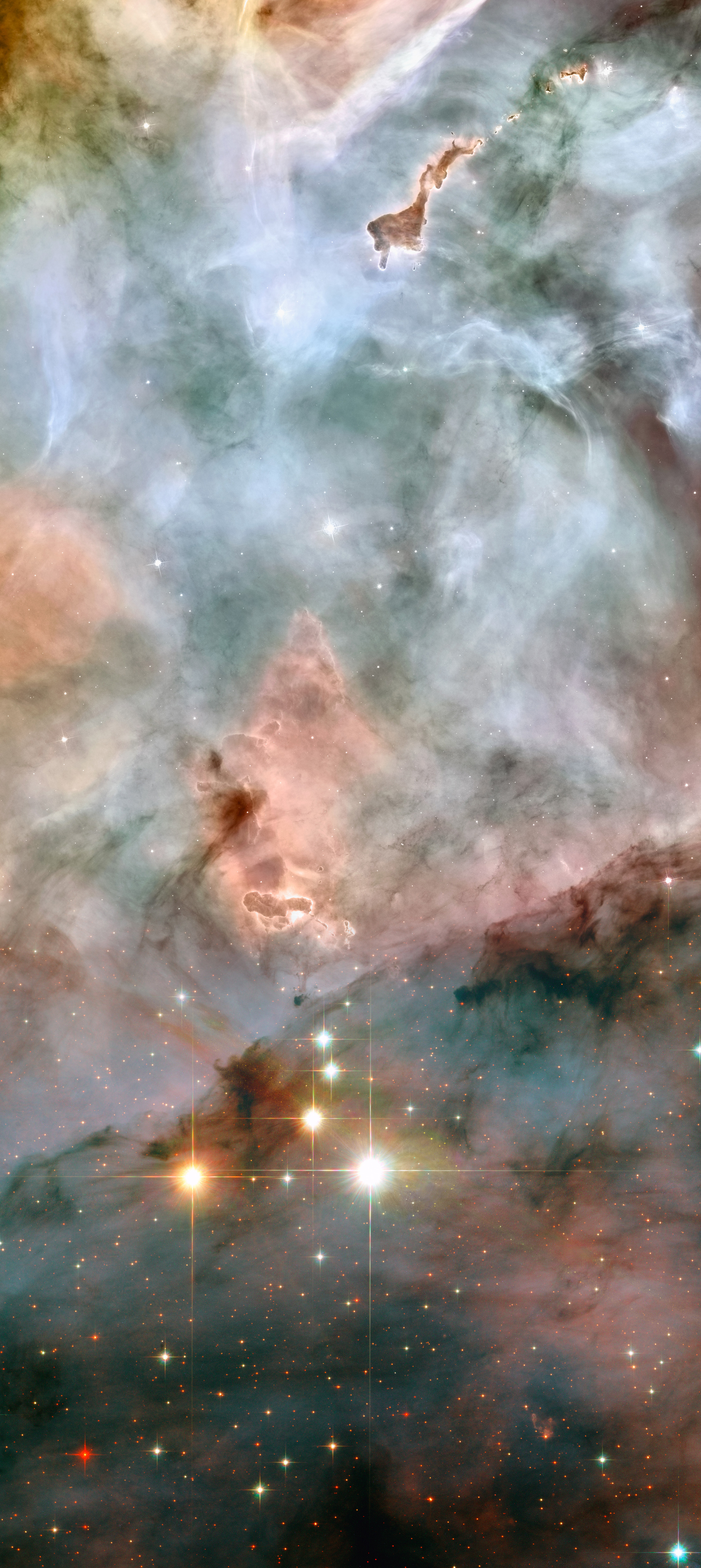
69. WR 25 and Tr16-244
WR 25 and Tr16-244, at the bottom of the image, are located within the open cluster Trumpler 16. This cluster is embedded within the Carina Nebula, an immense cauldron of gas and dust that lies approximately 7500 light-years from Earth in the constellation of Carina, the Keel. At the top of the image, a peculiar nebula with the shape of a “defiant” finger points towards WR25 and Tr16-244.
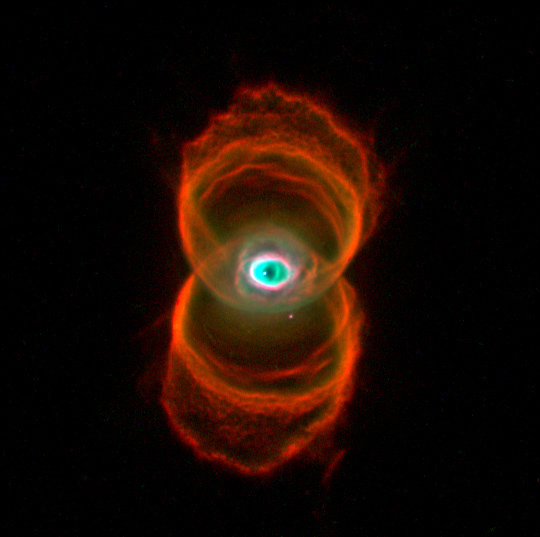
70. Hourglass Nebula
This Hubble image reveals the true shape of MyCn18, a young planetary nebula located about 8,000 light-years away, to be an hourglass with an intricate pattern of ‘etchings’ in its walls.
The results are of great interest because they shed new light on the poorly understood ejection of stellar matter which accompanies the slow death of Sun-like stars. In previous ground-based images, MyCn18 appears to be a pair of large outer rings with a smaller central one, but the fine details cannot be seen.

